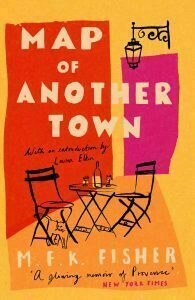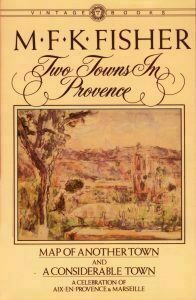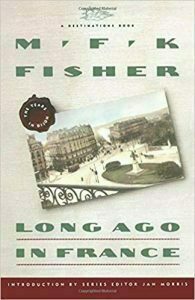Geraldene Holt remembers M.F.K. Fisher
7th November 2019
Geraldene Holt, Patron of the Oxford Cultural Collective, reflects on her friendship with celebrated US food writer, M.F.K. Fisher.
Late one afternoon in June 1985, I drove in to Aix-en-Provence looking for a quiet hotel where I could spend a few days writing my book, French Country Kitchen (1987). I found the ideal place, parked, and booked into a cool, pretty room. Then I set off for an evening stroll. At the end of the street, I discovered its name: Rue Cardinale. With a glow of pleasure I realized I was staying almost opposite the town house of Madame de Sévigné’s daughter, where, in the mid-fifties, in an attic bedroom, M.F.K.Fisher had lived.
Her book about Aix, Map of Another Town (1964), was in my hotel room and later I re-read her essay about 17 Rue Cardinale. It is, of course, not just a portrait of a house and its occupants, but a brilliantly observed account of female conduct.
Before leaving Aix I posted a card of the Four Dolphins fountain – which stands at the end of Rue Cardinale – to Mrs Fisher, at the address of her English publisher. I thanked her for making my stay in Aix so particularly enjoyable.
A few weeks later I was astonished to receive a reply from Mrs Fisher forwarded by my publisher. When I returned to England, Mary Frances – as she preferred to be known – and I began to correspond and she invited me to visit her in California. But, at this stage in my career, I was writing books and articles all day and everyday – with little free time.

It was, though, still a surprise, on an autumn day in 1989, when the telephone rang in the flag-stoned kitchen of our thatched farmhouse in Devon and a quiet voice spoke. ‘Geraldene, it’s Mary Frances. When are you coming to see me?’ I stammered an excuse about deadlines but promised to visit her soon. Mary Frances said she wanted to write the preface for the American edition of French Country Kitchen but would like to meet me in person first.
Early in November, I followed the road out of San Francisco, over the Golden Gate bridge, heading north to the Sonoma Valley. On Highway 12, just before Glen Ellen, I turned right onto the drive to the Bouverie Ranch. Mary Frances’ low Spanish-style house sat squarely at the foot of the Oakville range, surrounded by live oaks and madrona trees. Nearby, a monumental bell tower stood, alone, amid vineyards carpeted with wild flowers. Pinned to the front door of Last House, a scrawled notice read, ‘Friends – ring bell and come in. Foes – enter any old way.’ Knowing that both of us considered first impressions significant made me feel distinctly nervous. But bearing gifts – fresh local flowers, with wine from France, and bread from San Francisco – I was shown into the large study-bedroom to meet Mary Frances. At first, I couldn’t see her, the room appeared so dark after the dazzling Californian sunlight, but then I made out the smiling face of a slim, fine-boned woman sitting in an enormous leather chair with her legs resting on a support. Her low, careful voice welcomed me and we embraced warmly. Mary Frances asked me to sit in the wheelchair beside her, saying, ‘Then you’ll know how it feels,’ and we began to talk. We drank local white wine. ‘It’s just a goes-down-easy wine,’ she said, and we ate a light meal of vegetable soup and sandwiches served on trays on our laps.
Some hours later, as I began to say goodbye, Mary Frances stopped me and stated firmly that I was to stay as long as possible, and certainly until three days later, when her younger sister, Norah, would be arriving. ‘You can sleep on the couch in the living room – it’s delicious the first night, bearable the second and increasingly uncomfortable after that. Of course, the cats will want to share it with you.’
During the next few days we talked at length about writing and writers. ‘I never intended to be a writer, although I’ve always enjoyed writing,’ she said. ‘I simply write as I speak. I think about it for a long time, then I write fast with little revision. I grew up with a father who ran a newspaper and wrote two thousand words a day, come what may. Writing is the thing I do best; that, and cooking.’
At that time in 1989, Mary Frances still wrote every day, in her words, ‘slowly and with great pleasure’. She was then the author of twenty titles though she rarely read her earlier work; in Dubious Honors (1988) – a commentary on her prefaces to other authors’ books – she describes the dire results when she does so. But since I had brought several of her books with me, she kindly inscribed them in her almost illegible hand: in my well-travelled copy of Two Towns in Provence, she wrote ‘for Geraldene Holt, from Mary Frances (PS and my “Great Expectations” have been fulfilled).’

We discussed each of her books. A Cordiall Water (1961) was the book she liked most – she considered it contained her finest writing – alongside her translation of Brillat-Savarin’s The Physiology of Taste (1949).
Mary Frances then asked me to go to the deep cupboard at the far end of her study to select copies of her titles that I had not yet acquired. They included Sister Age (1983), with a jacket illustration of a small painting that she had bought in 1936 when she was in Zurich with Dillwyn (Tim) Parrish, ‘the love of my life’. The strange, dark painting was now hanging on the wall beside her desk. Mary Frances also gave me a copy of As They Were (1982), a collection of essays which she inscribed, ‘And as we are, Thank God.’
When it was time for Mary Frances to rest, I carried all the new books she’d given me on to the west veranda and sat in one of the big cane chairs surrounded by coral-pink geraniums and looking across the valley to the hills where Jack London had lived. I made notes of our conversations. Then opened As They Were and read the final essay in the book. Entitled Nowhere but Here, the piece describes Last House: how it came to be designed and built by David Pleydell-Bouverie, the English architect who was her neighbour and friend, and her decision to move there. Mary Frances concludes: “It is plain that creature comforts are an acceptable part of my choice to live here in my later years. Aside from them as well as because of them, I find this house a never-ending excitement, and I think this is as necessary when a person is in the seventies as in the teens and twenties. What is more, knowing why and where is much easier and more fun in one’s later years, even if such enjoyment may have to be paid for with a few purely physical hindrances, like crickety fingers or capricious eyesight.”
On the following day, I returned from a walk along the valley to find Mary Frances watching television. ‘Sit here next to me’, she said, ‘this is important’. It was the ninth day of November 1989 and together we were transfixed by the sight of hundreds of German people starting to dismantle the stonework as the Berlin wall began to fall.
Norah Kennedy Barr arrived two days later. She was tall and imposing with a naturally serious face but a ready and generous smile. While Norah prepared the meal for the three of us, in the kitchen at the far end of the big, sun-lit sitting room, she told me about her family and her adult sons.
The main course was a navarin of braised veal in a delicate wine sauce, followed by a leaf salad speckled with fresh herbs and served on the green plates described in As They Were. I smiled in recognition – I had bought the same plates, made in the Dieulefit pottery, for my house in the Ardèche. While Mary Frances slept we talked about how close both sisters had always been; ‘For Norah, again and always,’ reads the dedication to the book.
To the side of the dining table, a long chain of interlocking chicken wishbones swayed gently in the breeze from the open windows. Near the door to the entrance hall, a large-format book of modern French painting rested on a lectern, and I remember that each day the book was left open at a different painting. In the black-tiled hall, what appeared to be a complete collection of the works of Georges Simenon filled a long bookshelf. A few steps further on was the door to the large, handsome bathroom described in Nowhere but Here. I clearly recall that on one wall a framed copy of the living will of Mary Frances was surrounded by interesting paintings and photographs.
At the time, it didn’t strike me as odd that Mary Frances’ description of her Last House should be so accurate and truthful: that there was no attempt to portray anything beyond reality, no attempt to gild the lily. Now, years later, after reading all her work once more, I appreciate that this is a defining aspect of her writing, her commitment to complete and sometimes painful honesty. Often writing from notes made decades earlier, in Sister Age, she observes: “By now some of my notes sound like fabrications, invented to prove a point in an argument. This is because it is my way of explaining, and it has always been a personal problem, even a handicap. When I tell of a stubbed toe or childbirth, or how to serve peacocks’ tongues on toast, it sounds made-up, embroidered. But it is as it happened to me.” One is reminded that Antony Powell once said to Kingsley Amis: ‘In vino veritas – I don’t know, but in scribendo veritas – a certainty.’
Yet, even for a writer blessed with near perfect recall, Mary Frances found writing from memory an arduous business. She writes in Dubious Honors: “I sweated like a stevedore, literally, over the actual turmoil that I’d made for myself, because I was determined to prove that most of us do not remember the real facts of something from our childhood, but instead recall what we were told we remembered by our parents and teachers. It was as Hell itself to strip down all the wishful dreams of what had really happened.” Nor did Mary Frances find imaging or inventing any easier. In conversation, she told me: ‘I tried writing a novel once. It was no good. But I got it out of my system.’

“I have always been a reporter and perhaps a writer,” writes Mary Frances in Long Ago in France (1991), the book she was working on when I was her guest. She and Norah would set aside some time each day to look through boxes of papers, letters and postcards, dating from the time when Mary Frances and Al Fisher were newly married and living in Dijon in 1929. ‘I learnt to study and to think,’ she told me of the three years she lived there, on little money, in the gastronomic capital of France. “It was there, I now understand”, she writes, “that I started to grow up, to study, to make love, to eat and drink, to be me and not what I was expected to be. It was there that I learned it is blessed to receive, as well as that every human being, no matter how base, is worthy of my respect and even my envy because he knows something that I may never be old or wise or kind or tender enough to know.” Norah later joined them in Dijon and so, at Last House, the two sisters would talk about those days, remembering people and events of their shared past before Mary Frances wrote about that time.
On the last day of my stay, I drove over the Oakville Grade to the Napa Valley to visit the museum devoted to Robert Louis Stevenson whose writing both Mary Frances and I admired. Coming back in the twilight, over a level crossing, I accidentally drove off the road and onto the parallel railtrack so that my nearside wheels were on the sleepers and it was impossible to drive back over the rail. I knew the Napa Valley wine train would be approaching quite soon, and I was beginning to panic about the fate of my hired car, when four local people pulled up to help. Two drove ahead to stop the wine train, and another rang a garage to lift the car off the railtrack and change the damaged wheel.
Two hours later than expected, I returned to Last House. Mary Frances was waiting anxiously and was very concerned by what had happened. She sat in her wheelchair, craning forward, to hear every detail of my escapade. While I sipped whisky to calm my nerves, she put her hand on my arm and looked at me intently. ‘I know it was a dreadful thing for you to experience,’ she said, and, looking away, added quietly, ‘but, you know, it couldn’t happen to me.’ This was the only time Mary Frances referred to the Parkinson’s Disease which was already restricting her activity to the house.
By the time of my final visit to Mary Frances in May 1992, the illness had deprived her of most movement and her voice was hardly audible. Norah Barr had urged me to visit her sister, without delay, while I was staying in San Francisco, adding, ‘She’s so fond of you.’
Mary Frances was now very frail and confined to the high-sided bed at the far end of her study. As I walked into the room she waved her arm to greet me in the usual way and I saw that she had asked her nurse to dress her in a pale silk dress. She looked even more beautiful, her ivory skin remarkably unlined, her grey-green eyes undimmed. She lay in her table-high bed, smiling, serene, but dreadfully weak. Yet, she insisted on talking for some time and I had to hold my ear close to her mouth to hear her. I hope she couldn’t see how very upset I felt.
After a while she invited my husband and myself to go onto the verandah for a glass of wine. I knew I’d never see Mary Frances again, and my sadness was deepened by the sight of her now and by yet another reminder of her indomitable spirit and unfailingly generous nature.
It was this generosity, allied to her integrity and insight, that made her such a fine writer. Writing is inevitably about sharing, and Mary Frances shares her thoughts like no other writer on gastronomy. Her sensibilities make her fastidious with words, cajoling from them fresh nuances that awake and enlighten the reader.
She writes in a volume of photographs published five years after her death, A Welcoming Life – the M.F.K.Fisher Scrapbook (1997): “I do love words, their connotations, their uses and abuses.” And I’m reminded that in 1943 Mary Frances opens her fourth book, The Gastronomical Me, with a quotation from George Santayana: “To be happy you must have taken the measure of your powers, tasted the fruits of your passion, and learned your place in the world.”
Even in her lifetime, Mary Frances was described as a national treasure; she was praised by W.H.Auden, and dubbed a poet of the appetites by John Updike. Her writing does indeed celebrate our capacity for sensual pleasure; she relishes the complex and redemptive nature of love, and she savours hunger in all its forms. For many of us, her prose is itself sustenance.
M.F.K.Fisher died at Last House on 22 June 1992. Norah Barr wrote to tell me of the loss of her sister. In another letter, from a neighbour and good friend of Mary Frances, was a moving description of the simple funeral and how her ashes were scattered in a quiet place that she loved in the Californian countryside.
